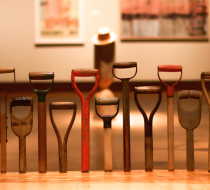Art faculty member Tom Loeser explores social interaction through handcrafted functional furniture pieces Favorite
Tom Loeser is currently the Chair of the UW-Madison Department of Art, and specializes in woodworking and furniture. From his studio on the east side, he produces many functional and beautiful furniture pieces. He’s also a vibrant community member; he crafted the interactive reception desk at the Madison Children’s Museum with his wife as well as the “reading pods” at the Madison Public Library with Dave Chapman. Loeser's work is featured in the Faculty Exhibition at the Chazen Museum of Art where three of his furniture pieces and a series of his prints are on display. The Chazen hosts each of the faculty artists for a forum about their pieces, and during his talk on Thursday, Loeser revealed the root of his passion for furniture.
What first sparked Loeser’s interest in creating his unique seating pieces were the colorful metal handles of shovels. In 1991, Loeser began rescuing metal and wooden shovels out of garbage cans with the intention to create a fence in his yard. As he began collecting more, his love for rustic seating led him in a different direction: his own furniture style. Alas, the revolution of plastic handles started to eliminate his available supply, forcing him to hunt down these coveted shovels at garage sales and auctions. After removing the handle from the shovel, he uses them as the backs and legs of benches. Loeser joked that since he only uses the top halves, he is still brainstorming about how to use the bottom halves, so stay tuned for more great work. As for the substance of the bench, he uses raw wood slabs. He leaves the sides the unfinished, often with blemishes and uneven edges. The flat side, which is made for sitting, is finished with a light gloss, creating a high contrast between the raw, natural edges and the glossy top. Loeser was very clear that he intentionally chooses both the slab of wood and the pattern in which he finishes it. He believes that exposing a portion of the raw wood “tells you something unique about the tree [it came from], embracing all the cracks, all the knots, all the imperfections; it is not just a piece of wood that went through a machine.” Supporting his love for the natural world, he gets his wood from local companies that remove urban trees for building, transforming an unfortunate destruction into a new life as a piece of art, adding even more character and beauty to his work.
Tom Loeser’s wanderings in rustic furniture grew into an interest in how seating situations affect social interaction. While he began by making more traditional furniture shapes, he has recently branched out to adjusting seating positions to change how the seated people may interact. For example, instead of putting the back of the bench on the long side, as it is done traditionally, he placed the back rests on each short side so that the seaters would have to straddle the bench facing each other. This, in its own way, can be both an intimate and intimidating experience. His other furniture piece at the show can seat three people, but it separates each person by a wall of shovel handles, each facing out at a different direction. This seating arrangement allows for minimal social interaction and would stunt any conversation. His new innovatively shaped yet rustically styled furniture pieces play with human social interaction, a central idea that led to his expansion to two-dimensional works.
Tom Loeser’s expansion into other mediums was a great addition to the art show and enhanced the meaning of his furniture. The handcrafting of 60 differently shaped metal brands of his chairs was only the means to an end for Loeser. He heats each brand, done when dark outside to more easily gauge the temperature of the metal, and burns the shape into heavyweight watercolor paper. Tom commented that there is an element of finality to the branding process which makes it challenging, but incredibly rewarding. He brands the chairs in different arrangements, to tell a story of both interaction and isolation on one page. In the same way, he does this on cyanotype, a photographic blueprint paper that reacts to UV light. Anything placed on the paper that casts a shadow or completely covers a portion of the paper will fade to various shades of white depending on coverage. Loeser made a series of miniature wooden chairs to place on the paper and leave their impressions behind, creating many shades of blue from well placed shadows and the movement of the sun. Loeser was attracted to these two mediums in particular as the heat of the sun and the fire of branding are both a threat to the wooden creations he admires and creates. Fire and heat are elements that can easily consume wooden objects, which creates a beautiful dichotomy in his furniture.
Loeser’s work in an asset to the Faculty Exhibition in his exploration of furniture as a vehicle for social interaction. His excitement to be a member of the Madison community further brings out the beauty of his work. If you are interested in more of his work, check out his book entitled, “It Could Have Been Kindling.”
http://www.dailycardinal.com/article/2016/02/art-faculty-member-tom-loes...







